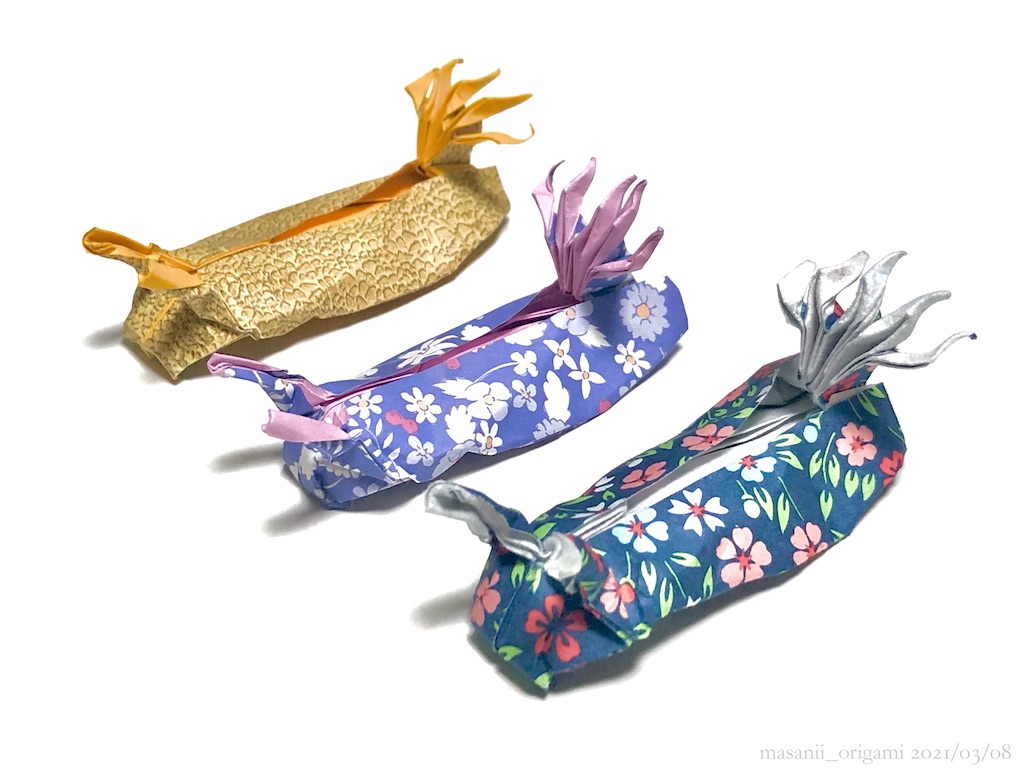
前回に引き続き、「第21回折紙探偵団コンベンション折り図集Vol.21」の作品をお届けいたします。
(前回:2021/03/01)
masanii-origami.hatenablog.com
Continuing from the previous article, I'll show you a work in "The 21st ORIGAMI TANTEIDAN CONVENTION".
今日ご紹介するのは「ウミウシ」です!
マニアックですね〜。
こんなモノまでデザインする人がいるなんて、折り紙の懐の深さを感じます。

Today I'll introduce "Sea slug".
How unique!!
What a deep Origami world is that there's such a design.
考案者は、メキシコのエリック・ジャクシエル・リーバス・ザルコさん。
This model was designed by Eric Jacksiel Rivas Zarco, in Mexico.
折り図はなんと、スペイン語です!
前回の「飛ぶカブトムシ」は英語でしたが…さすがにスペ語は初体験です。
果たして、無事に完成できるのでしょうか!?
Amazingly, the diagram is written in Spanish!
"Flying Kabutomushi (Beetle)" I posted last time, was written in English, but I've never experienced Spanish.
Can I successfully complete it!?
❶折り図の大切さ/Importance of the diagram
❷シンプルでも油断は禁物/Careless mistake
❸ウミウシのはなし/About Sea slugs
☘️☘️☘️
❶折り図の大切さ/Importance of the diagram
さて、さっそく始めましょう。
えーと、まず…

Now, let's begin.
Hmm, first of all...
1. Plegar y desplegar en ángulo bisector.
読めねぇ!!
Can't read!!
2. Plegar en valle los bordes llevandolos al medio.
読めねぇ!!!!
Can't read!!!!
でも、大丈夫!
こんな時の強〜い味方が「折り紙の共通ルール」です。
山折り・谷折りのラインや矢印の形、記号や順序の付け方などは、ほとんどのテキストで統一されています。
But it's Okay!
In such a case, ORIGAMI common rules strongly help me.
How to indicate Mountain fold & Valley fold, the shape of the arrow, any symbols , and how to describe the procedure, are unified in most textbooks.
それは音楽でいう「譜面」のようなもの。
言葉が分からなくても、ルールに従って進めていけばOKです。
かつて先人たちが「共通言語」を整備してくれたおかげで、こうして私たちが世界中の作品を楽しむことができるんですね。
They're like musical scores.
It's Okay if you proceed according the rules, even if you can't understand the language.
Thanks to our great ancestors who developed these common languages, we can enjoy any Origami works all over the world, in this way.
ちなみにGoogle先生によると、さっきの文章は、
1. 二等分線の角度で折り畳んで展開します。
2. それらを中央に導く谷の端を折ります。
By the way, according to Google Translation, the Spanish sentences I mentioned above, turned out to be as follows.
"1. Fold and unfold at a bisector angle."
"2. Fold the edges in a valley leading them to the middle."
う〜ん、なんか微妙に違うような気がします。
でも分かるような、分からないような…
Hmm, I feel something is wrong.
Maybe I can understand them, but I also feel that I can't...
❷シンプルでも油断は禁物/Careless mistake
ありがたい「共通ルール」に基づいて、サクサクと進めていきます。
書籍自体がマニアックとはいえ、この作品は前回のカブトムシほどの残酷さはありません。

I proceeded diagrams smoothly according to the thankful common rules.
Although this textbook itself is unique, this model isn't so harsh, compared to the previous Beetle.
だって、2ページ・38工程しかないんだもん!
「飛ぶカブトムシ」は20ページ・343工程。10倍です。10倍ですよ奥様。
Because it have only 38 steps in 2 pages!
On the other hand, Beetle has 343 steps in 20 pages.
What? 10 times!? OMG!!!
紙のサイズも15cm×15cm、つまり普通の教育折り紙と同じ大きさでイケました。
(推奨サイズは18cm×18cmでしたが、まぁ大丈夫でした。)
ちなみにカブトムシは53cm×53cm。何このギャップ。
I could make using 15cm×15cm paper, that is nomal size.
(Textbook recommends 18cm×18cm, but it's almost Okay.)
でも、油断はいけませんね。
楽勝!と思っていたら、工程26のClosed sinkでビリッとやってしまいました。
(幸い、おしりの内側だったので上手く隠せました。)
簡単・難しいに関わらず、どんな作品に対しても常に丁寧・謙虚でいたいものです。

However, I should have been careful.
When I thought it was easy, the paper was torn at closed sink in step 26.
(Fortunately the broken part was inside the hip, I could hide it well.)
I should be polite & humble for any models, regardless of difficulty.
❸ウミウシのはなし/About Sea slugs
ウミウシは「海の宝石」とも呼ばれ、世界中で様々な種類が知られています。
そのカラフルで美しい姿は、写真集ばかりかキャラクターグッズまで作られる程の人気ぶりです。
Sea slug is often called "Sea jewel", and known various species all over the world .
The colorful & beautiful appearance is so popular that their photo books or figures are even on sale.
今回の作品は「Hypselodoris apolegma」、つまり「シンデレラウミウシ」という種をベースにデザインされているものです。
Today's model is desined as "Hypselodoris apolegma = Royal hypselodoris".
ウミウシは軟体動物、つまり貝の仲間です。
貝殻は進化の過程でなくなりましたが、小さな名残が残っている種類もいます。
Sea slug is a mollusca, same as shellfish.
The shell has degenerated in the process of evolution, but some species have traces of them.
ちなみにウミウシの眼は、頭の突起の根本あたりにちょこんと存在しています。もしくは、目を持たない種もあるそうです。
てっきりカタツムリのように、頭の突起が眼そのものかと思っていました。
Sea slug eyes are extremely small and at the base of the protrusions on his head.
They're some species who have no eyes.
I was misunderstanding that eyes are at the top of the protrusions like a snail.
ウミウシは、日本にも普通にいます。
磯を探し回ると、たま〜に岩の間に紛れていたりします。
私は高校生の頃に生物部に入っていたのですが、フィールドワークでメリベウミウシを見つけた時は大いに盛り上がりました。
懐かしい素敵な思い出です。
Sea slug also live Japan.
If you search for the shore carefully, they may be lurking in a puddle between the rocks.
I belonged to Biology club when I was in high school.
During fieldwork, when we found a Melibe (a kind of Sea slug), we were very exited!
It's my nostalgic & wonderful memory.
☘️☘️☘️
メキシコ人作家・エリック・ジャクシエル・リーバス・ザルコさんの「ウミウシ」でございました。

I intrduced "Sea slug" designed by Eric Jacksiel Rivas Zarco, in Mexico.
折り図という「共通言語」さえ知っていれば、書く人・見る人どちらも、完全に同じビジョンを共有することができます。
Once you learn diagram = Origami common language, content can be shared exactly between creators and players.
YouTubeの動画も素晴らしいですが、見たいところが手で隠れたり、光の加減でラインが見えなかったり、思うように折れない事もあるんですよね。
(それでも、様々な工夫を凝らしてそれらを克服するクリエイターの方々に、感服するばかりです。)
I think YouTube is also suitable for enjoying Origami, but sometimes I can't proceed as I expect.
The parts that I want to check may be hidden by creator's hand, or the creases may become invisible due to the influence of direction or intensity of light.
(That aside, I have a great respect for video creators who overcome those problems with various ingenuity!)
「もっと上手くなりたい」「色々な作品を折ってみたい」という方は、テキストを買って、折り図のルールを確認すると良いですよ。
そこは、壮大な世界への入口です!
If you want to improve your skill or challenge more various models, get some textbooks and check the common rule.
There's an entrance to the magnificent world!
過去に、折り図についてのコラムを書いているので、こちらも良かったらご覧くださいませ。
(2018/10/24)
masanii-origami.hatenablog.com
In the past, I wrote an article about the diagram of Origami, you should check out!
(I'm sorry that it's only in Japanese.)
【参考ウェブサイト/Reference website】